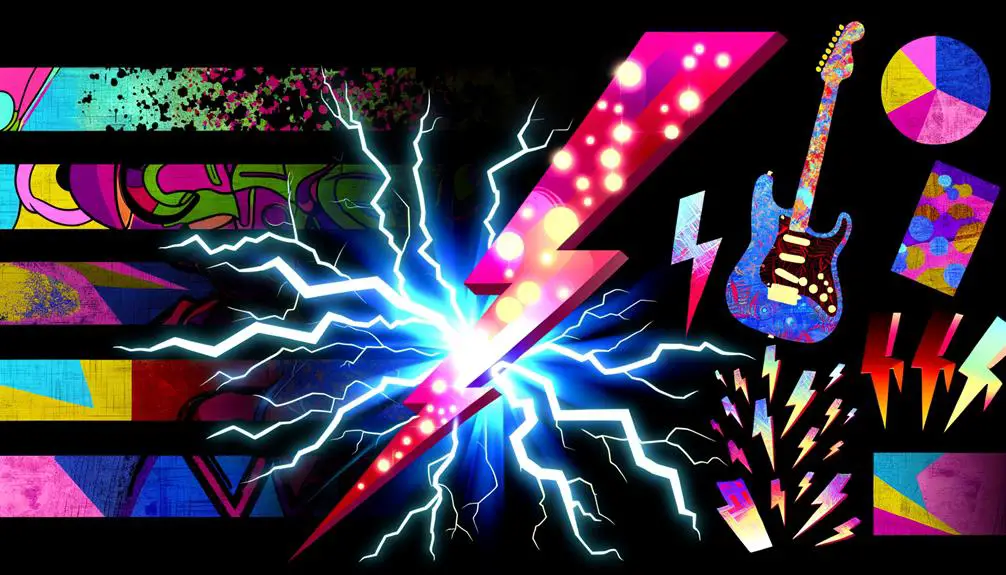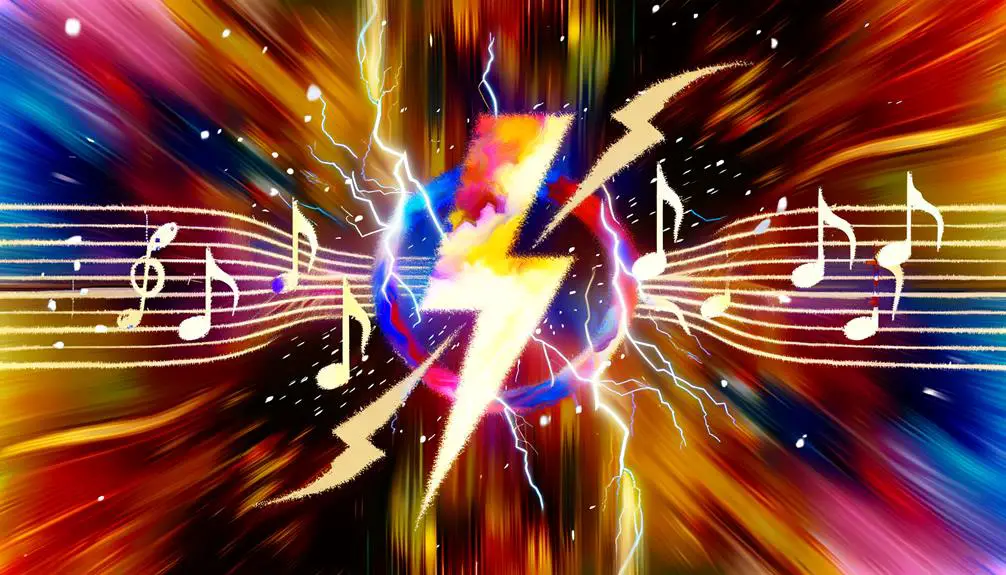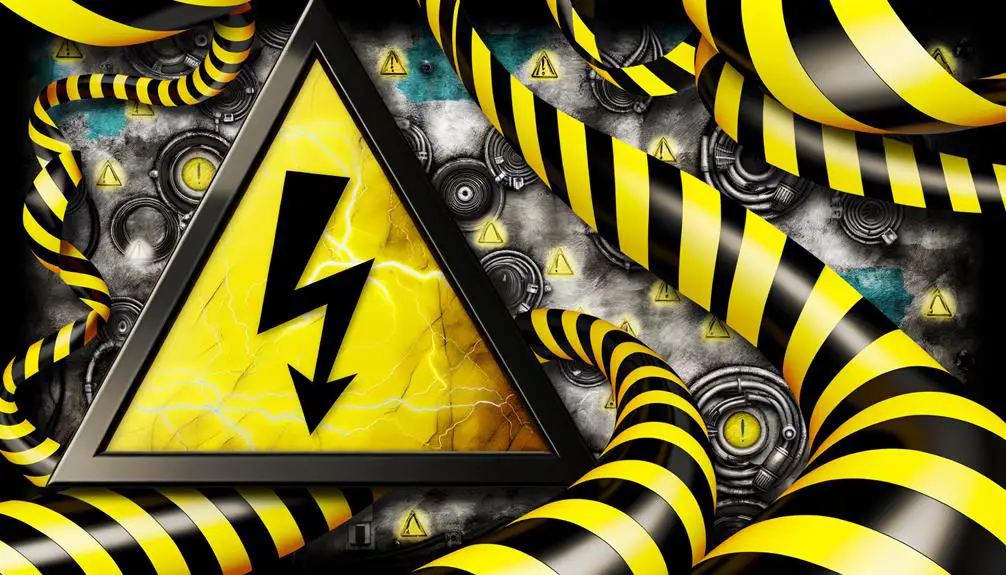How to Interpret the Meaning of the Lightning Bolt Symbol
The lightning bolt symbol universally connotes power, speed, and divine intervention. Historically, it has been associated with deities such as Zeus and Thor, symbolizing supreme authority and control over natural elements.
In modern culture, it represents swiftness, rebelliousness, and high energy. Technologically, it illustrates cutting-edge innovation and high-speed data transfer.
Superhero imagery, such as The Flash, utilizes the symbol to denote extraordinary velocity. In music and art, it signifies dynamic energy and transformation.
Understanding the multifaceted implications of the lightning bolt symbol opens doors to appreciating its widespread resonance across different domains.

Key Takeaways
- Represents divine power, authority, and control over natural elements in ancient mythology.
- Symbolizes speed, power, and rebellion in modern culture and fashion.
- Signifies superhuman abilities, energy, and rapid action in superhero imagery.
- Embodies moments of clarity, breakthroughs, and dynamic change in personal growth.
- Associated with cutting-edge performance and sustainability in technological innovation.
Ancient Mythology

In ancient mythology, the lightning bolt symbol was mainly associated with deities and was often interpreted as a manifestation of divine power and authority. This symbol denoted control over natural elements and was emblematic of supreme force.
For instance, in Greek mythology, Zeus wielded the thunderbolt as a weapon, signifying his dominance over gods and humans. Similarly, in Norse mythology, Thor's hammer, Mjölnir, was often depicted with lightning, underscoring his role as a thunder god.
This recurrent theme underscores the transcultural attribution of the lightning bolt to figures of immense power and influence. Such associations indicate a universal symbolic language wherein lightning represents not only physical might but also the capacity to influence and control natural and supernatural domains.
Religious Significance
The lightning bolt symbol holds profound religious significance, often representing divine intervention and the presence of a higher power across various belief systems. In Christianity, it can symbolize God's omnipotence and sudden acts of divine will, as evidenced in biblical passages where lightning accompanies divine communication.
In Hinduism, it is associated with Indra, the god of thunder and rain, symbolizing both his destructive and life-giving powers. In Greek mythology, Zeus wields the lightning bolt, serving as a symbol of his supreme authority and ability to enforce cosmic order.
Such consistent symbolism across different religions underscores the lightning bolt's role as a powerful emblem of divine authority and supernatural influence. This unifying iconography highlights its universal religious resonance.
Modern Pop Culture

Prominently featured in modern pop culture, the lightning bolt symbol has become an enduring icon representing speed, power, and rebellion. Its ubiquitous presence spans various media and consumer products, from fashion to entertainment. The symbol's adoption in these contexts underscores its versatility and cultural resonance.
| Media Type | Example |
|---|---|
| Music | David Bowie's Aladdin Sane |
| Fashion | Off-White™ Collections |
| Technology | USB Charging Indicators |
| Entertainment | Harry Potter Scar |
In music, David Bowie's alter ego, Aladdin Sane, popularized the symbol. Fashion brands like Off-White™ utilize it to convey a sense of edginess. Technology employs the lightning bolt to denote high-speed data transfer, while in literature, it marks significant character traits. The symbol's adaptability across these domains highlights its multifaceted significance.
Superhero Imagery
Among the myriad of symbols associated with superheroes, the lightning bolt stands out as a quintessential emblem of extraordinary speed and energy. This iconography is notably exemplified in characters such as The Flash, whose lightning bolt insignia symbolizes his superhuman velocity.
The lightning bolt conveys an immediate visual cue, signaling dynamic power and rapid action. Its sharp, angular design suggests both physical prowess and an almost electrical intensity. In the realm of superhero imagery, the lightning bolt also represents a connection to natural forces, aligning the character with elemental strength.
This symbol's recurring use underscores its effectiveness in communicating attributes of agility, potency, and relentless momentum, establishing it as a critical visual shorthand in superhero lexicons.
Music and Art

In music and art, the lightning bolt symbol frequently appears in iconic band logos and album covers, serving as a potent visual metaphor.
This symbol often signifies energy, power, and transformation, resonating with the dynamic and electrifying nature of musical expression.
Notable examples include its use by bands such as AC/DC and David Bowie, where it enhances the thematic and aesthetic impact of their work.
Iconic Band Logos
Several iconic band logos, incorporating the lightning bolt symbol, have greatly influenced both music and visual art culture. Prominent examples include AC/DC's emblematic logo, which uses a stylized lightning bolt to symbolize the band's electrifying energy and dynamic performances.
Similarly, the Grateful Dead's 'Steal Your Face' logo features a lightning bolt, signifying the transformative power of their music. The lightning bolt in these logos serves as a visual shorthand for attributes like power, speed, and raw energy, which are central to the bands' identities.
These designs utilize the lightning bolt not merely for aesthetic appeal but to encapsulate and convey the essence of the musical experience, thereby establishing a powerful brand presence in the cultural zeitgeist.
Symbolism in Album Covers
Expanding on the use of the lightning bolt in band logos, album covers also employ intricate symbolism to convey deeper meanings and evoke emotional responses, intertwining music with visual art.
The lightning bolt, often seen on album covers, can symbolize:
- Power and Energy: Representing intense emotions and dynamic musical compositions.
- Rebellion and Change: Signifying a break from tradition, aligning with revolutionary themes in music.
- Mysticism and Enlightenment: Denoting sudden insight or inspiration, often linked to lyrical content.
These symbolic elements serve to enhance the listener's engagement with the music, providing a visual narrative that complements the auditory experience.
Sports Logos
The lightning bolt symbol is prominently featured in the logos of various sports teams, signifying speed, power, and energy. Its dynamic imagery conveys a sense of urgency and strength, making it an ideal choice for teams seeking to project dominance and agility. This symbol is utilized across multiple sports disciplines, from football to hockey, each adopting the lightning bolt to reflect their unique attributes.
| Team Name | Sport |
|---|---|
| Los Angeles Chargers | Football |
| Tampa Bay Lightning | Ice Hockey |
| Melbourne Lightning | Netball |
The adoption of the lightning bolt symbol in sports logos is a strategic decision aimed at fostering a psychological edge. It encapsulates the essence of athleticism, galvanizing both players and fans, and reinforcing the team's identity as fast, formidable, and full of vigor.
Safety and Warning Signs

Beyond the world of sports, the lightning bolt symbol serves a critical function in safety and warning signs, where it is universally recognized as an indicator of electrical hazards and high-voltage areas. This symbol is essential for preventing accidents and ensuring the safety of personnel. Its usage is standardized across many industries, making it an effective visual cue.
Key applications include:
- Electrical Panels: Marking access points to potentially dangerous electrical components.
- High-Voltage Equipment: Indicating machines and devices that operate at high voltage levels.
- Cautionary Signs: Warning individuals to maintain a safe distance from hazardous areas.
The widespread adoption of the lightning bolt symbol underscores its importance in maintaining safety protocols and mitigating electrical risks in various environments.
Technology and Innovation
Integrating the lightning bolt symbol into modern technology serves as both a functional and aesthetic element, enhancing user interfaces and product designs. This symbol is often employed to indicate high-speed capabilities, such as fast charging on electronic devices, or to denote power and energy efficiency.
In software applications, the lightning bolt can signify rapid processing or high-priority actions. Its visual simplicity allows for quick recognition, reducing cognitive load and improving user experience. Additionally, its universal appeal guarantees consistency across different platforms and cultures.
Technological advancements have further embedded the symbol in innovative contexts, such as renewable energy systems and electric vehicles, where it underscores cutting-edge performance and sustainability. Hence, the lightning bolt remains a pivotal icon in technological innovation.
Personal Symbolism

In personal symbolism, the lightning bolt often represents sudden insight, inspiration, and the power of transformative energy. This potent emblem can be dissected into three primary elements:
- Epiphany and Innovation: The lightning bolt signifies a moment of clarity or breakthrough, akin to a sudden flash of genius or novel idea.
- Dynamic Change: It embodies rapid transformation, symbolizing swift shifts in thought, perspective, or circumstances.
- Empowerment: The lightning bolt conveys a surge of energy and empowerment, equipping individuals with the vigor needed to pursue ambitious goals.
These attributes make the lightning bolt a compelling personal symbol, encapsulating the essence of intellectual and emotional dynamism. Its representation of abrupt, yet profound change resonates deeply within those experiencing pivotal life moments.
Conclusion
The lightning bolt symbol, transcending epochs and cultures, epitomizes a multifaceted iconography. From ancient mythology's divine wrath to modern technology's innovation, its reverberations are omnipresent.
This symbol, found in religious texts, popular culture, and safety warnings, serves as a potent emblem of power and transformation. As an enduring motif, the lightning bolt continues to electrify the collective consciousness, embodying both danger and inspiration, a proof of humanity's quest for meaning and progress.






